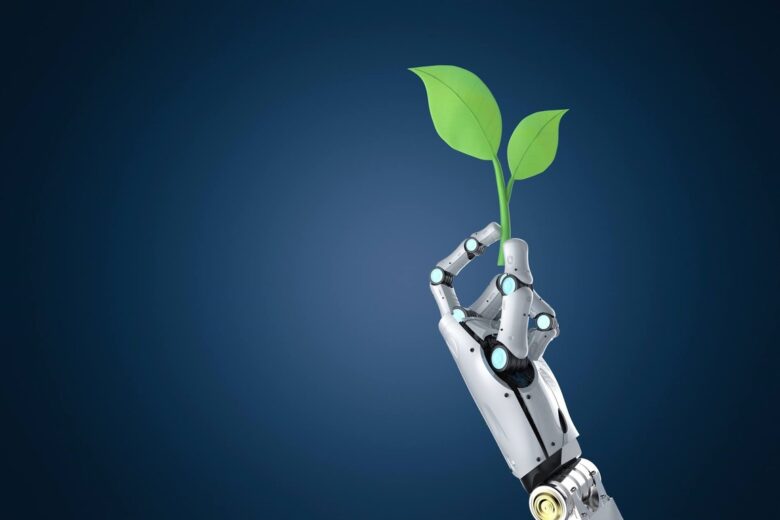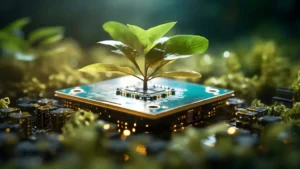The world is changing rapidly; sustainability is no longer an option but a necessity. As the climate situation becomes increasingly critical, industries are turning to environmentally friendly technologies that combine responsibility with innovation. One of the most notable disciplines in this shift is green robotics, a fascinating combination of environmental sustainability and automation. Green robotics essentially reflects the direction of technology development, not only to be greener but also to provide smarter solutions.
These robotic systems help companies reduce their carbon footprint by integrating smart processes, energy-saving technologies, sustainable materials, and smart systems. Ecotechnology changes the way machines interact with their environment and spans across sectors from industry to agriculture and even aerospace. This article delves deeply into the field of green robotics, encompassing its fundamental components, current applications, advantages, and the prospects for responsible automation in the future.
Definition of Green Robotics:
Green robotics refers to robotic systems that are built with sustainability as a primary goal. Energy-saving technologies, eco-friendly materials, and operating procedures that reduce waste and emissions help in the production of these machines. Unlike traditional robots, which rely on non-renewable resources and consume a lot of energy, green robots focus on optimizing production and reducing environmental impact. These robots are usually powered by solar or wind energy, but can also be built with recyclable or biodegradable parts. This shift in design thinking is essential in the current global trend toward a circular economy. Green robots are a holistic concept that combines automation with environmental protection, not just practicality.
The Role of Green Robots in Sustainable Manufacturing:
The industrial sector is one area where green robots play an important role. Robotic systems that can reduce energy consumption, minimize material waste, and maximize production technology are being integrated into smart factories. Through real-time data analysis, these green robots can adjust their operations to meet demand and efficiency, thereby reducing emissions and operating expenses. For example, some robots go into standby mode when not in use, which saves electricity. Other robots can help humans reduce physical stress and improve safety, thereby improving the work environment. As Industry 4.0 shapes the future, the competitiveness and responsibility of businesses depend on their combination of automation and sustainability.
Eco-Friendly Robots in Agriculture:
Green robotics technology is revolutionizing agriculture by enabling precision farming and making it a more sustainable farming method. Today, self-driving tractors, solar-powered drones, and harvesting robots can perform tasks such as planting, watering, and agricultural monitoring with minimal disruption to the environment. By using sensors to assess soil conditions, identify pests, and maximize water use, these robots help reduce reliance on hazardous chemicals and unnecessary waste of resources. This sustainable automation can also help farmers increase yields while protecting ecosystems. In addition, such technologies can reduce human intervention in hazardous environments, making agriculture safer and more efficient. Green robotics is making agriculture smarter, greener, and more efficient.
Robotics and Renewable Energy: A Perfect Combination
The symbiosis of green robotics and renewable energy is one of its most compelling features. Robots powered by solar panels or wind energy can operate without increasing greenhouse gas emissions. Solar-powered robots are used in remote areas for data collection, environmental monitoring, and surveillance, effective even in places where human activities could be problematic or dangerous. Urban environments use renewable-powered robots for building maintenance, waste management, and even cleaning. As battery technology advances and renewable energy becomes more popular, the potential for these robots to replace traditional energy-dependent systems grows exponentially. This fusion makes green robots not only a tool for automation but also a beacon of environmental development.
Robotic Waste Management and Recycling:
Waste management and recycling are two areas critical to the health of the environment, and green robotics is leading the way in both. Robots are developing advanced sensors and artificial intelligence to sort and separate recyclables more effectively than humans. By distinguishing between plastic, metal, and organic waste, these smart technologies have significantly increased recycling rates. Robotic arms help accurately process hazardous waste in landfills, reducing the risk to people and improving safety. Additionally, automation technology can track and capture trends in waste production, allowing communities to develop better waste reduction plans. Green robots can significantly contribute to creating better communities and cleaner cities through improved accuracy and efficiency.
The Economic Returns of Green Robots:
While green robots are expensive to start up, the long-term economic benefits can be significant. Businesses that use these systems often see lower maintenance expenses, lower energy bills, and improved operational efficiency. Green robots are a smart financial decision because the long-term savings can outweigh the initial cost. Companies that implement eco-technologies can also strengthen their brand image and attract consumers who care about the environment. To encourage the adoption of sustainable technologies, governments and international organizations also offer subsidies and incentives to increase their economic viability. We anticipate a worldwide explosion in adoption as more industries recognize the benefits of green robots.
Concepts Driving Green Robotics:
Green robots are entering a new era, driven by advances in artificial intelligence, machine learning, and materials science. To extend the lifespan of robots and reduce waste, researchers are developing self-healing materials and biodegradable parts. Artificial intelligence is being used to optimize the real-time behavior of robots to ensure low energy consumption. Concepts such as swarm robotics (multiple robots working together efficiently) are being studied for environmental monitoring and disaster relief. As the Internet of Things (IoT) becomes increasingly connected, green robots can interact and communicate with other systems, making automation smarter and more sustainable. These developments are leading to a future where eco-friendly technologies permeate all aspects of modern life.
Challenges and Ethical Issues:
Despite its promising prospects, green robotics technology faces many challenges. High development costs, technical limitations, and a lack of standardization can hinder its implementation, especially in less developed regions. Ethical issues also arise from job losses, data privacy, and the environmental impact of industrial robots themselves. In addition, ensuring that all components used in these robots are truly sustainable is an ongoing challenge. Solving these issues requires collaboration between communities, legislators, and engineers to arrive at open and inclusive answers. Ensuring that green robots benefit the environment and society relies on regulation, education, international cooperation, and technology.
Future Outlook: A Greener Future for Robotics
With the rapid growth of technology and popularity, the future of green robotics looks bright. As environmental regulations become stricter and public knowledge increases, more and more companies will consider sustainable automation as a viable solution. Green robotics is also beginning to find its way into the curriculum of educational institutions, helping to cultivate a new generation of environmentally conscious engineers and designers. With the continued development of sustainable materials, renewable energy, and artificial intelligence (AI), the next generation of robots will be more environmentally friendly and efficient. It is expected that green robots will not only become an integral part of business in the coming decades but also a necessary part of daily life, creating a more sustainable and balanced planet.
Conclusion:
Green robots are no longer a futuristic idea but an imminent invention. As the climate situation becomes increasingly serious, it is crucial to use sustainable technology in various industries. Green robots combine environmental management with automation capabilities to provide a viable solution. From revolutionizing manufacturing and waste management to redefining agriculture, these eco-friendly tools are changing how we interact with the planet. Green robots can function effectively and lessen environmental harm, making them a cornerstone of sustainable development. Such innovation not only increases production but also creates a better planet for future generations through continued investment, creativity, and global collaboration. The result means not just smarter machines, but smarter living.
FAQs:
1. What is the definition of a “green” robot?
Green robots typically use renewable energy, eco-friendly materials, and energy-saving systems to reduce their impact on the environment, and their manufacturing concept also reflects sustainability.
2. Are green robots pricier than traditional robots?
Although green robots have a higher initial cost, the long-term benefits of low energy consumption and low maintenance expenses make them economically viable in the long run.
3. Can green robots cope with environmental changes?
Green robots can significantly reduce the impact of climate change by reducing carbon emissions, improving efficiency, and decreasing waste.
4. In which sectors will green robots have the greatest impact?
The main beneficiaries are manufacturing, agriculture, waste management, and energy; however, green robots are increasingly being used in many other sectors as well.
5. Are green robots suitable for startups?
Even small businesses can implement scalable green robotics technology to improve sustainability, given its increasing popularity and government incentives.




